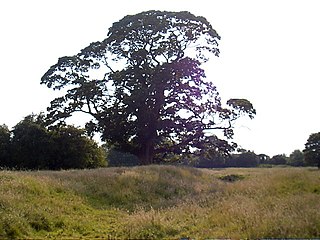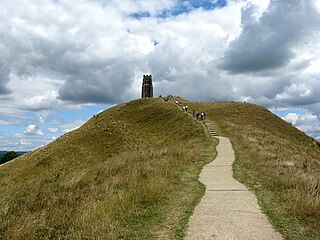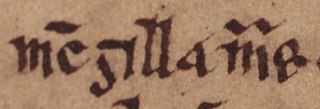Ælla or Ælle is the first known king of the Anglian kingdom of Deira, which he ruled from around 560 until his death in 588.

Meaux Abbey was a Cistercian abbey founded in 1151 by William le Gros, 1st Earl of Albemarle, Earl of York and 4th Lord of Holderness, near Beverley in the East Riding of Yorkshire, England.
Thomas Wykes, English chronicler, was a canon regular of Oseney Abbey, near Oxford.
Sitric Cáech or Sihtric Cáech or Sigtrygg Gále, was a Hiberno-Scandinavian Viking leader who ruled Dublin and then Viking Northumbria in the early 10th century. He was a grandson of Ímar and a member of the Uí Ímair. Sitric was most probably among those Vikings expelled from Dublin in 902, whereafter he may have ruled territory in the eastern Danelaw in England. In 917, he and his kinsman Ragnall ua Ímair sailed separate fleets to Ireland where they won several battles against local kings. Sitric successfully recaptured Dublin and established himself as king, while Ragnall returned to England to become King of Northumbria. In 919, Sitric won a victory at the Battle of Islandbridge over a coalition of local Irish kings who aimed to expel the Uí Ímair from Ireland. Six Irish kings were killed in the battle, including Niall Glúndub, overking of the Northern Uí Néill and High King of Ireland.
This is list of Irish language exonyms for places outside Ireland. The tables contain both exonym and endonym of places around the world. The exonyms in Irish and the endonyms in their regional language.

Hugh de Stafford, 2nd Earl of Stafford, 3rd Baron Stafford, 3rd Baron Audley, KG was an English nobleman.

The Chronicles and Memorials of Great Britain and Ireland during the Middle Ages, widely known as the Rolls Series, is a major collection of British and Irish historical materials and primary sources published as 99 works in 253 volumes between 1858 and 1911. Almost all the great medieval English chronicles were included: most existing editions, published by scholars of the 17th and 18th centuries, were considered to be unsatisfactory. The scope was also extended to include legendary, folklore and hagiographical materials, and archival records and legal tracts. The series was government-funded, and takes its unofficial name from the fact that its volumes were published "by the authority of Her Majesty's Treasury, under the direction of the Master of the Rolls", who was the official custodian of the records of the Court of Chancery and other courts, and nominal head of the Public Record Office.
Ragnall mac Bárid ua Ímair or Rægnald was a Viking leader who ruled Northumbria and the Isle of Man in the early 10th century. He was a grandson of Ímar and a member of the Uí Ímair. Ragnall was most probably among those Vikings expelled from Dublin in 902, whereafter he may have ruled territory in southern Scotland or the Isle of Man. In 917, he and his kinsman Sitric Cáech sailed separate fleets to Ireland where they won several battles against local kings. Sitric successfully recaptured Dublin and established himself as king, while Ragnall returned to England. He fought against Constantín mac Áeda, King of Scotland, in the Battle of Corbridge in 918, and although the battle was not decisive it did allow Ragnall to establish himself as king at York.

St Swithun upon Kingsgate is a Church of England church in Winchester, Hampshire, England, built in the Middle Ages in the Early English style. Located above the medieval Kingsgate, one of the principal entrances to the city, the church is unusual in forming a part of the fabric of the old city walls. St Swithun's first appears in 13th century records, and under the fictional name of St Cuthbert's, is mentioned in Anthony Trollope's novel The Warden.
The 1254 papal election took place following the death of Pope Innocent IV and ended with the choice of Raynaldus de' Conti, who took the name Pope Alexander IV. The election was held in Naples, in the former palazzo of Pietro della Vigna, and required only one day.
Sir Osbern Pentecost was a Norman knight who followed Edward the Confessor to England upon Edward's return from exile in Normandy in 1041.
William Maunsell Hennessy (1829–1889) was an Irish official and scholar.
Drogo de la Bouerer was a Flemish associate of William the Conqueror, who was rewarded after the conquest with a large grant of land in northern and eastern England, primarily in Holderness, where he built Skipsea Castle.
The Warenne Chronicle, also known as the Hyde Chronicle and Chronicon monasterii de Hida iuxta Winton ab anno 1035 ad 1121, is a chronicle concerning the history of England and Normandy at about the time of the Norman Conquest. The chronicle exists in the form of a thirteenth-century manuscript which is preserved on folios 4r–21v of British Library Cotton MS Domitian A XIV. It may have been written for William of Blois, Count of Boulogne and his wife, Isabel de Warenne, Countess of Surrey, to give an account of her grandfather, William de Warenne, 2nd Earl of Surrey.
Thomas Oswald Cockayne (1807–1873) was a churchman and philologist, best known today for his monumental edition of Old English medical texts.

On 11 September 1275, an earthquake struck the south of Great Britain. The epicentre is unknown, although it may have been in the Portsmouth/Chichester area on the south coast of England or in Glamorgan, Wales. The earthquake is known for causing the destruction of St Michael's Church on Glastonbury Tor in Somerset.
Admiral Sir Peter Bard was an English Knight and naval officer who held a number of important commands of the Navy Royal from 1314 to 1336. and Admiral of the West from 1314 to 1315 and again from 1338 to 1339. Vice-Admiral of the West in 1337. and Admiral of the Fleet of the Cinque Ports from 1335 to 1336.

Ragnall Mac Gilla Muire was a twelfth-century leading figure of Waterford. He was one of several men taken prisoner by the English in 1170, when Waterford was captured by Richard de Clare. Ragnall is noted by a fourteenth-century legal enquiry which sought to determine whether a slain man was an Ostman—and thus entitled to English law—or an Irishman. Ragnall may the eponym of Reginald's Tower.
John de Asgarby was Chancellor of the University of Cambridge in 1267.
Henry (de) Blaneforde or Blankfrount was an English chronicler and a Benedictine monk of St. Albans. He wrote a short continuation of the chronicle of Trokelowe for the years 1323 to 1324.






